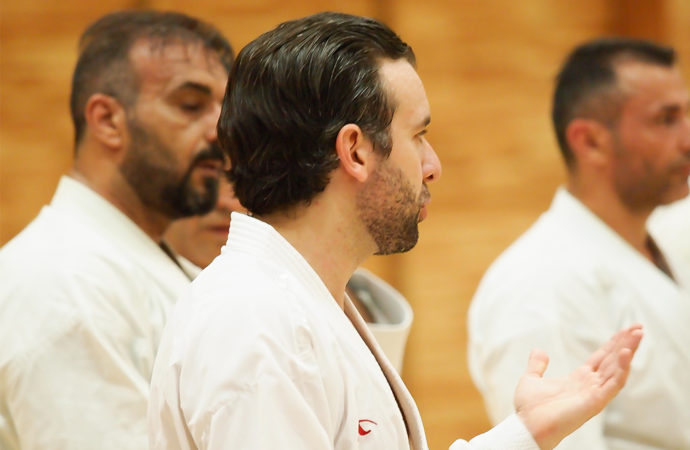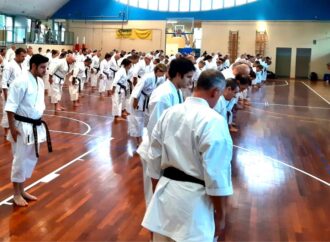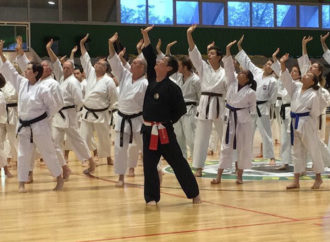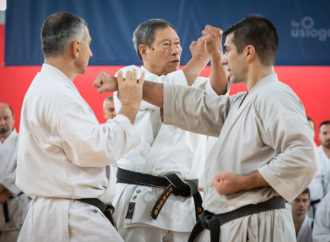The 5 steps to profitably administrate your dojo.
(Versione italiana in calce)
How can a dojo be classified as successful? By the medals it wins in competition or the Instructor’s credentials? How about the number of students it has? Or is it by the number of full-capacity classes it has during a week? It’s not a simple question, however, from a strictly business point of view, a dojo is successful only if it is profitable. As simple as that…
A dojo must balance a strong technical foundation and solid business management.
Many Karate instructors often fear approaching a dojo because they think failing, business-wise, may damage their reputation, or have a negative impact in the Karate community. A dojo must balance a strong technical foundation and solid business management. We hear of many great instructors and top-level competitors who own dojos, but their expectations are not fulfilled by their results in business. In many cases the Cash Flow is slow, and sometimes negative; in others communicating with parents becomes an issue; now and then the initial investment has been too high, and at times marketing and social media expenses run out of control. But, in most cases, failure is a matter of lack of proper management tools and methods.
As a Karate Instructor for over a decade now and a dojo owner myself, I’ve identified 5 key processes that have helped me not only to reach a breakeven point fast, but also to enjoy successfully performing on both sides of the tatami, inside and out. This is not a recipe, but rather key questions you need to ask yourself and your team periodically; the answers will pave the way to a roadmap that would guide you, and take you where you want to be.
- Training: the technical side or what happens on the tatami. From a business angle, it is your product.
Key questions: Who’s your target? Is it children under 12, teenagers, seniors? What are they looking for: self-defense, conditioning, competition? How many classes will you teach during a weekday, weekends? Is the Instructor following a program, improvising, or simply repeating class after class? Is the Instructor capable? Define your product, it’s a must. - Marketing: If you don’t sell the product, who does? A strategic marketing plan is the secret not only to differentiate yourself from the competition, but to capture new students and keep the cycle going. In all dojos, students come and go, however it is recommended to use simple and low cost marketing media, such as the social networks, to create brand awareness, and if successful enough, to highlight the attractiveness of your dojo.
Key questions: How much time or money are you willing to invest monthly? How much does a new student cost? Do you have a graphic designer? Do you know anything about social media management, advertising, or PR (Public Relations)? It is fundamental to create dojo awareness as soon as possible. - Fundraising: it doesn’t matter if you own one dojo or ten dojos, raising funds is crucial to reaching big, challenging goals. Dreams come in many sizes: sometimes as a world championship you want to participate in, or maybe a seminar. Every so often, they come as the construction of an office, a new dojo, or to bring a top level competitor into the organization. In any case, if you don’t have the funds, go out and knock on some doors.
Key questions: Whose doors will you knock? What will you show, and offer, to that potential sponsor? A letter, a presentation, nothing at all?! Are there any tangible, measurable benefits or incentives for the sponsor? What kind of exposure will they have? Is their support tax deductible? Can you make a long-term alliance with that company or person? - Administration: This is without a doubt a critical process in dojo management. Without clear, reliable, but, above all, well-organized administrative processes, you might as well be the lost son of Bruce Lee, but your dojo is not going to be successful.
Key Questions: Are your students paying on time? Do you charge late fees? Do you sell suits, shirts and protective gear? What is your “cross selling index”? How many months a year does your average student pay? What’s your “average ticket”? Are you paying competitive salaries to your instructors? Are they happy? How many dropouts do you have per month? What’s your “attrition rate”? Do you make a profit at the end of each month? Do you have any cash or capital reserves for any contingency? Plan your success, don’t improvise it. - CRM (Customer Relationship Management): Who pays for classes, the parents? In that case, parents are as important as your students. You should keep them happy; they need attention and above all, they need information. Be mindful that in many cases parents do not understand the dynamics of the Karate world and the feedback is often too slow.
Key questions: How often do you meet with parents? Do you send them emails or text them frequently? Birthday gifts? Christmas party? Do they feel you care? Are you building a community?! That is the question! And do they also have fun?
If you don’t sell the product, who does?
When I opened my first dojo I did not have the answers to all these questions…
Managing a dojo can be complicated, but if you divide the challenge into a series of small, well-defined tasks, it’s perfectly doable. It’s your choice. When I opened my first dojo I did not have the answers to all these questions, but I followed good advice: I asked for help. If you don’t know something, then ask someone who knows.
Good Luck.
Gestisci il tuo dojo con successo!
I 5 step per amministrare al meglio la tua palestra di karate.
In base a cosa un dojo può essere definito di successo? Alle medaglie vinte in gara? Alle credenziali del maestro? Al numero di studenti che lo frequentano? O, ancora, a seconda della quantità di lezioni al completo offerte settimanalmente? Non è una domanda a cui è facile rispondere. Da un punto di vista strettamente commerciale un dojo è di successo solo quando è redditizio. Parrebbe semplice…
Un dojo deve saper bilanciare delle salde fondamenta tecniche con una solida gestione aziendale.
Molti insegnanti di karate spesso hanno paura di avviare un dojo temendo che un fallimento, dal punto vista commerciale, possa compromettere la loro reputazione o danneggiare la comunità del karate. Un dojo deve saper bilanciare delle salde fondamenta tecniche con una solida gestione aziendale. Si sente spesso di numerosi insegnanti competenti e di agonisti di alto livello che hanno un dojo, ma le cui aspettative non sono soddisfatte dai risultati commerciali. In molti casi il ritorno economico è lento e spesso in negativo; in altri la comunicazione con i genitori è problematica; in altri ancora l’investimento iniziale è stato eccessivo o, a volte, si perde il controllo degli investimenti, per esempio per il marketing e i social media. Tuttavia, nella maggior parte dei casi, il fallimento è da ricondurre a una mancanza di strumenti e metodi manageriali adatti.
In qualità di insegnante di karate con più di dieci anni di esperienza e come proprietario di un dojo ho identificato 5 TEMI fondamentali che mi hanno aiutato non solo a raggiungere rapidamente la soglia di redditività, ma anche a godere dei successi dentro e fuori il tatami. Questa non è una ricetta, ma sono piuttosto domande fondamentali che hai bisogno di porre periodicamente a te stesso e al tuo team. Le risposte apriranno la strada alla mappa che ti guiderà e ti porterà dove vuoi andare.
- Allenamento: la parte tecnica, ciò che succede sul tatami. Da un punto di vista aziendale è il tuo prodotto.
Domande fondamentali: qual è il tuo target? Bambini sotto i 12 anni, adolescenti o adulti? Cosa stanno cercando? Autodifesa, preparazione, competizione? Quante lezioni vuoi offrire durante la settimana o nel weekend? L’insegnante segue un programma, improvvisa o semplicemente ripete, lezione dopo lezione? L’insegnante è capace? Definisci il tuo prodotto, è imprescindibile. - Marketing: se non sei tu a vendere il tuo prodotto, chi lo fa? Un piano di marketing strategico è il segreto non solo per differenziarsi dalla concorrenza, ma anche per acquisire sempre nuovi studenti e garantire la ciclicità. In tutti i dojo gli studenti vanno e vengono. É auspicabile utilizzare strumenti semplici e low cost come i social media per far conoscere la tua attività e, se di successo, per sottolineare l’attrattiva del tuo dojo.
Domande fondamentali: quanto tempo e quanti soldi sono disposto a investire mensilmente? Quanto costa un nuovo studente? Hai un graphic designer? Sai qualcosa di social media management, pubblicità o PR (Public Relations)? Far conoscere al più presto il proprio dojo è fondamentale. - Fundraising: non importa se possiedi uno o dieci dojo, raccogliere fondi è cruciale per aspirare a raggiungere obiettivi importanti. I sogni sono di grandezze diverse: la partecipazione a campionati mondiali, o anche solo un seminario, la costruzione di un nuovo ufficio, o di un nuovo dojo o, ancora, l’acquisizione di un agonista di alto livello. Qualsiasi esso sia, se non ci sono fondi, bisogna uscire e andare a “bussare alle porte”.
Domande fondamentali: alla porta di chi busserai? Cosa mostrerai e offrirai a quel potenziale sponsor? Una lettera, una presentazione o niente?! Vi saranno alcuni benefici tangibili e misurabili o incentivi per lo sponsor? Che tipo di pubblicità ne trarranno? Il loro supporto è detraibile dalle tasse? Puoi stabilire un’alleanza a lungo termine con questa azienda o persona? - Amministrazione: questo è senza dubbio un processo critico nella gestione del dojo. Senza processi amministrativi chiari, affidabili, ma, soprattutto, ben organizzati, puoi anche essere il figlio perduto di Bruce Lee, ma il tuo dojo non potrà avere successo.
Domande fondamentali: i tuoi studenti pagano puntualmente? Ci sono more per pagamenti in ritardo? Vendi karategi, magliette o protezioni? Qual è il tuo tasso di vendita abbinata di più prodotti? Quanti mesi all’anno paga il tuo studente medio? Qual è il prezzo medio? Paghi stipendi competitivi ai tuoi insegnanti? Sono felici? Quanti studenti al mese abbandonano le lezioni? A quanto ammonta il tasso di rinuncia? Crei utili alla fine di ogni mese? Disponi di riserve in contanti o in capitale per ogni evenienza? Pianifica il tuo successo, non improvvisarlo. - Gestione e fidelizzazione dei clienti: chi paga per le lezioni, i genitori? In quel caso i genitori sono tanto importanti quanto gli studenti. Dovresti far sì che siano soddisfatti, necessitano attenzione e soprattutto informazioni. Tieni a mente che in molti casi i genitori non capiscono le dinamiche del mondo del karate e il feedback è spesso troppo lento.
Domande fondamentali: quanto spesso incontri i genitori? Mandi loro e-mail o messaggi frequentemente? Regali di compleanno? Festa di Natale? Hanno la sensazione che ti importi? Stai costruendo una comunità?! Questa è la domanda! Si stanno divertendo anche loro?
Marketing: se non sei tu a vendere il tuo prodotto, chi lo fa?
Quando ho aperto il mio primo dojo non avevo le risposte a tutte queste domande.
Gestire un dojo può essere complicato, ma se ripartisci la sfida in una serie di piccoli compiti definiti, è perfettamente fattibile. La scelta sta a te. Quando ho aperto il mio primo dojo non avevo le risposte a tutte queste domande, ma ho seguito un ottimo consiglio: ho chiesto aiuto. Se non sai qualcosa, chiedi a qualcuno che la sa.
Buona fortuna.

















